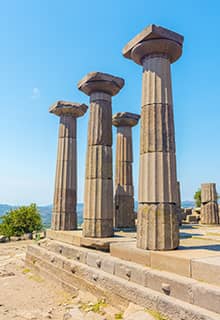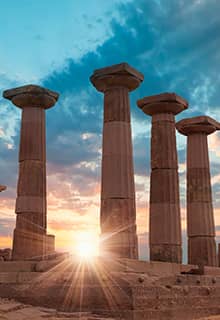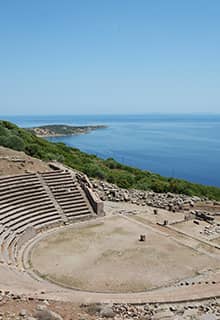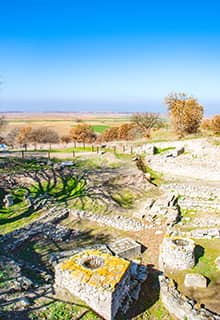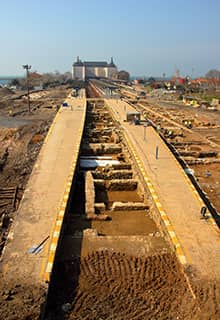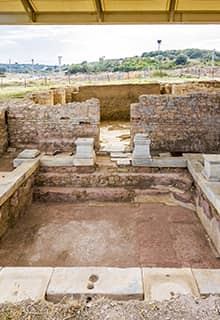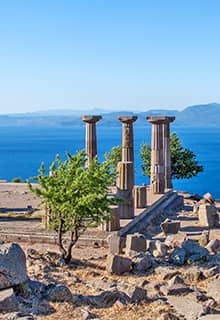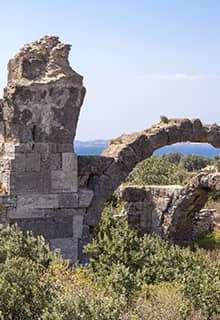

historical sites Marmara
Türkiye
- Apamea Myrlea, Bursa
- Apollonia ad Rhyndacum, Bursa
- Cius, Bursa
- Germanicopolis, Bursa
- Orestias, Edirne
Alexandria Troas, Çanakkale
Alexandria at Troas is located at Odun İskelesi, Dalyan Village, 55 km south of Çanakkale. The ferry to Tenedos (Bozcaada) also leaves from here and it is easy to access. The city was also the ancient port city in the Troad, founded by Antigonus I Monophthalmus, one of the generals of Alexander the Great, he named the city Antigoneia. After the death of Antigonus, another Macedonian commander, Lysimachus renamed to Alexandria, in honor of Alexander the Great. Because there were many cities called Alexandria in those days, this particular Alexandria was given the term "Troas" or "from the Troad." Today’s visitor to the city enjoys a bath, five odeons, a theater, a gymnasium, a necropolis, a nymphaeum, and a recently discovered stadium, dating back to 100 BCE. The aqueduct of Emperor Trajan is located in the eastern part of the city.
Assos, Çanakkale
Assos is perhaps one of the most scenic and magnificent ancient cities in Türkiye. It’s location and view to Lesbos Island over the Aegean, makes a visit to the city great fun. The ancient city is situated on a rocky hill, on the territory of modern Turkish village of Behramkale. Archaeological evidence shows that the area was inhabited as early as the Bronze Age and the “ss” in its name suggests the Anatolian Origin of the city. In the 4th century BCE was a period of great prosperity for Assos when Hermeias, a student of Plato, ruled the city, as well as the rest of the Troad peninsula. In 348 BCE Aristotle came to Assos and established a philosophical school where he taught for three years. The city can be visited in two parts, the acropolis, and the lower city. Acropolis hosts the earliest Doric Temple in Anatolia, the temple of Athena, the fortification walls, and a Turkish Mosque from the early period. You can follow the path down to the lower city and visit the agora, bouleuterion, gymnasion, and enjoy the great view of Lesbos from the theater. A visit to Assos must include a refreshment down at the harbor, where there are several hotels and restaurants housed in the old customs buildings.
- Cardia, Çanakkale
- Cebrene, Çanakkale
- Lamponeia, Çanakkale
- Limnai or Limnae, Çanakkale
- Lysimachia, Çanakkale
- Marpessos, Çanakkale
- Neandreia, Çanakkale
- Sestos, Çanakkale
- Sigeion, Çanakkale
- Skepsis, Çanakkale
Parion, Çanakkale
Parion is located at the village of Kemer, some 90 km east of Çanakkale. The name of the city, thought to be found around 709 BC, was derived from the Trojan prince Paris. This assumption leading to the fact that Paris was educated in the city, in turn, gave the city the name “Parion” meaning the “City of Paris” the city became wealthy during the Roman Period, the theatre, odeion and the baths of the city are the solid proofs of this situation. Parion, which became a city inhabited by the Christians starting from the 5th century CE is understood to be an important Bishopric centre of the Byzantine Period due to the presence of various priests who were sent here. An important detail related to the Christianity Period of the city is that it became the Archbishopric Center of the Empire at the time of the Emperor Constantine Porphyrogennetos in the 10th century CE.
Troy (Hisarlik), Çanakkale (Troia)
Troy, or as it is mentioned in the Iliad, Troia, is located at the entrance of the Dardanelles, 30 km west of Çanakkale. The strait holds a significant place in history and is also the scene of the legend of the two lovers Hero and Leander. In 480 BC, the Persian army of Xerxes I crossed the strait on a pontoon bridge, and Alexander the Great did the same in 334 BC on his expedition against Persia. The strait has always been of great strategic and economic importance as the gateway to İstanbul and the Black Sea from the Mediterranean. Excavations have identified a sequence of nine principal stratas representing nine periods, and another layer just discovered in 2019, dating Troia back to 3600 BCE. Troy VIIa, which was destroyed by fire sometime about the 13th century BC, is probably the city of King Priamos described in Homer’s Iliad. Homer immortalized Troy in the stories of King Priam, Hector, Paris, and the beautiful Helen. A symbolic wooden Trojan horse commemorates the legendary war. Recent excavations left no doubt that Troia was an Anatolian city, the discovery of a chalcolithic mound on the Dardanelles closed the historical gap, the Luwian seal discovered proved Luwian contact of the city. The Hittite texts which talk about t treaty between the Hittites and Wiluşa Price Alexandu, can easily be traced to Wiluşa to Ilios, and Alexandu was another name for Paris. The Greek Troia was called Wilusa / Taurisa, during the Bronze Age. Troia is also officially claimed ancestry the Roman Empire through Aeneas. Today the city walls of Troia VI, stands as a reminder to the great Homeric city that resisted the Greeks. The temple of Athena, Megaron Palaces of Troia II, Palace of Priamos from Troia VI, Demeter sanctuary, Odeon and bouleuterion from the Roman Period are still in relatively good condition. The new Museum at Troia houses several precious items from the site, many of the treasures of Troia. The treasures which were taken away by famous Heinrich Schliemann hopefully will arrive back home soon too.
Chalcedon (Khalkedon – Kadıköy), İstanbul
Chalcedon, the ancient name for Kadıköy district of İstanbul, is been recently excavated around the famous Haydarpaşa train station, archaeologists unearthed a wealth of historical ruins, including tombs, artifacts, and a bath, all hinting of the rich past of the ancient city of Khalkedon also called "the Land of the Blind.” When Byzas arrived at this area with an oracle in his pocket, oracle told him to establish his city across the land of the blind. Seeing the great logistic advantages of Golden Horn, he thought that people of Chalcedon are blind as they have not settled here but on the other side. Excavations for subway construction revealed historical remains. The digs, started in 2018 by Türkiye's Culture and Tourism Ministry and İstanbul Archeological Museums, have been done with the utmost care for the last two years. Digs revealing historical structures from Classical, Hellenistic, Roman, Byzantine, Ottoman eras shed light on the deep roots of Türkiye, a cradle of civilizations.
- Drusipara, Kırklareli
- Nicomedia (Capital of Bithynia), Kocaeli
- Apros, Tekirdağ
- Charax, Yalova

